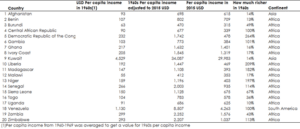“What we measure informs what we do. And if we’re measuring the wrong thing, we’re going to do the wrong thing.” – Joseph Stiglitz, Nobel Prize Winner in Economics, 2001
There is no shortage of ideas and strategies that will lead a country from poverty to economic prosperity. From strategies that tout the benefits of investments in primary education to others that focus on healthcare, or from import substitution policies to significant investments in infrastructures, billions of dollars are spent annually in an effort to help poor countries ascend to economic prominence. Unfortunately, many poor countries that have received billions of dollars in aid, grants, and low interest loans over the past few decades are still poor today. And perhaps what is more painful is that their prospects are only slightly better than they were decades ago. With increasing populations in many of these regions, we must change our development strategy.
Table 1. 20 countries that are poorer today than they were in 1960, by measure of GDP per capita

In spite of receiving aid for poverty eradication programs from the World Bank and other international development organizations, these countries have become more poor over the last half century | Source: International Monetary Fund (IMF) World Economic Outlook
Correlation versus causation
As the Nobel Laureate, Joseph Stiglitz notes in the quote above, whatever we measure will inform what we do. As such, we must ensure that we are measuring the right things. Unfortunately, in the world of international development, we have become so adept at measuring that we no longer leave room for the possibility that we might be measuring the wrong things.
Understandably, most explanations for economic growth and prosperity focus on conditions or incentives at the global, national, or industry level. They correlate prosperity with factors such as a nation’s culture, education, foreign aid, infrastructure, corruption, and other factors. While each of these factors has some impact on helping a nation achieve economic growth, none is the causal mechanism behind why a nation prospers. And in many cases, because the research deals with correlation rather than causation, factors that affect economic growth positively in one study have been found to have no impact or a negative impact on growth in another study. Many economists, for instance, still debate whether or not foreign aid is good or bad for economic development.
This is why we must focus on innovation. Innovation is the causal mechanism for creating prosperity because it introduces newer and typically better ways of tackling pressing problems that make society more productive. Increasing productivity in society ultimately leads to prosperity.
Innovation: the causal mechanism
At the Christensen Institute, we define innovation simply as the way a person or an organization chooses to solve a particular problem. Innovation can be high-tech or low-tech, digital or analog, and can be done in a small or large organization. Focusing on innovation reaps major rewards, as evidenced by Taiwan’s transformation over the past 70 years.
In 1949, Taiwan was very poor. Consider the following. First, the average per capita income in the country was $100. By contrast, the per capita income in the United States during that time was around $9,500. Second, approximately 60 percent of the eight million Taiwanese engaged in agriculture as their main source of income, a hallmark of a poor country. Third, inflation in 1948 was 520 percent followed by 3,500 percent in 1949. And finally, with the exception of some textile factories, sugar refineries, and food processing plants, Taiwan practically had no industries.
But Taiwanese entrepreneurs focused on innovations that targeted the vast nonconsumption in the country. They developed products that people had been unable to afford or access. For example, due to the reduction in Japanese imports, one of the most sought after products in the country was textiles, so Taiwan focused on textile production. The Taiwanese government established import policies that favored plant, machinery, and raw materials that helped the country develop a manufacturing base. By investing in innovations that targeted nonconsumption, the country was also able to create employment opportunities. Creating employment is one of the most important effects of an innovation-focused strategy.
Interestingly, at the time, development organizations in Taiwan, such as USAID, also focused on investing in innovations that targeted nonconsumption in Taiwan. For instance, in 1958 a Taiwanese entrepreneur, Wang Yung-Chin, founded Formosa Plastics Group after he received a $798,000 loan from USAID. Formosa has grown to become one of the world’s largest plastics companies. As opposed to implementing a development strategy mostly focused on improving many of today’s important human development indicators, such as years in school and life expectancy at birth, the development strategy focused on investments in market-creating innovations.
The strategy has paid off handsomely for Taiwan. Today, the region enjoys a GDP per capita of approximately $47,000 (one of the highest in the world) and a life expectancy of greater than 80 years. Also, the average Taiwanese citizen has access to water and sanitation, quality education, and healthcare. All the things that development organizations are pushing onto poor countries, with limited success, have been achieved by Taiwan. Development organizations played a critical role in Taiwan’s development as they supported the country’s investments in innovations that solved both local and global problems. These investments ultimately created the jobs that the Taiwanese so desperately needed.
Lessons for us
While Taiwan’s development story illustrates the effectiveness of an innovation-driven strategy, it’s important to understand that there is no one-size-fits all strategy for development. Innovation is simply the way people or organizations choose to solve problems, and because problems differ from region to region, the solutions that come about will also differ. What’s clear, however, is that innovations that target nonconsumption not only solve local problems that plague particular societies, but also have the potential to create employment for the millions of poor people living in extreme poverty.
Give a person a mosquito net and she might use it; but give a person a job and she will not only buy a mosquito net, but also take care of her family. Our development strategy must focus on innovations that accomplish the latter.
For more, see:
Crime will rise in cities like Lagos, but we have the tools to stop it


